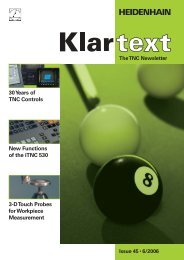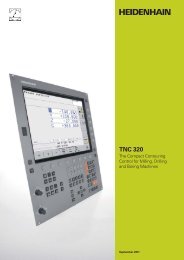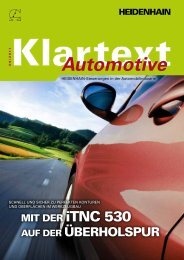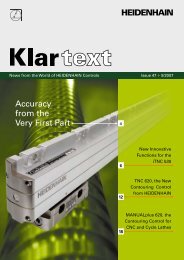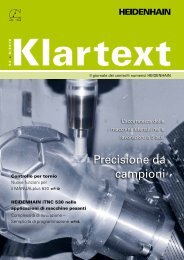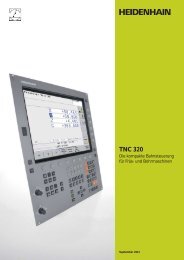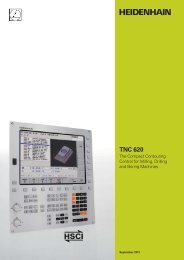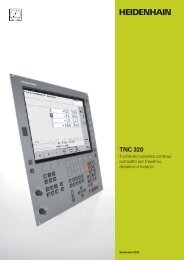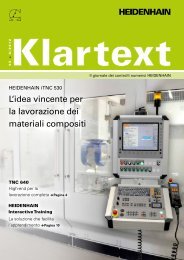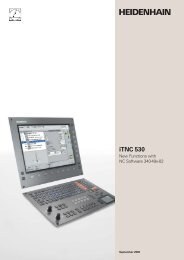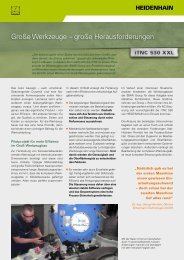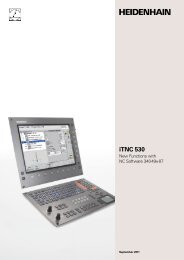iTNC 530 - TNC 640 - DR. JOHANNES HEIDENHAIN GmbH
iTNC 530 - TNC 640 - DR. JOHANNES HEIDENHAIN GmbH
iTNC 530 - TNC 640 - DR. JOHANNES HEIDENHAIN GmbH
You also want an ePaper? Increase the reach of your titles
YUMPU automatically turns print PDFs into web optimized ePapers that Google loves.
Intelligent Machining<br />
– Option for Adaptive Feed Rate Control (AFC)<br />
Besides the feed rate for each block or<br />
cycle, <strong>HEIDENHAIN</strong> controls have always<br />
allowed the programmer to enter a manual<br />
compensation through the override<br />
potentiometer to adjust for the actual<br />
machining situation. But this always<br />
depends on the experience and, of<br />
course, the presence of the operator.<br />
Adaptive feed rate control (AFC)<br />
automatically regulates the feed rate<br />
of the <strong>TNC</strong>, taking into consideration<br />
the respective spindle power and other<br />
process data. In a teach-in cut, the <strong>i<strong>TNC</strong></strong><br />
records the maximum spindle power. Then,<br />
before actual machining, you defi ne in a<br />
table the respective limit values between<br />
which the <strong>i<strong>TNC</strong></strong> can infl uence the feed rate<br />
18<br />
in the adaptive control mode in the<br />
“control” mode. Of course, various<br />
overload reactions can be provided for,<br />
which can also be defi ned by your machine<br />
tool builder.<br />
Adaptive feed rate control offers various<br />
advantages:<br />
Optimizing the machining time<br />
Fluctuations in dimensions or material<br />
(blowholes) often appear particularly on<br />
cast parts. With a corresponding adaptation<br />
of the feed rate, the control tries to keep<br />
the previously "learned" maximum spindle<br />
power during the entire machining time.<br />
The total machining time is shortened by<br />
an increased feed rate in the machining<br />
zones with less stock removal.<br />
Tool monitoring<br />
The <strong>i<strong>TNC</strong></strong>'s adaptive feed rate control<br />
permanently compares the spindle power<br />
with the feed rate. As a tool becomes<br />
blunt, the spindle power increases. As a<br />
result, the <strong>i<strong>TNC</strong></strong> reduces the feed rate. As<br />
soon as the feed rate falls below a defi ned<br />
minimum, the <strong>i<strong>TNC</strong></strong> reacts with an error<br />
message or by switching off. This helps to<br />
prevent further damage after a tool breaks<br />
or is worn out.<br />
Protection of the machine mechanics<br />
Reducing the feed rate down to the<br />
reference value whenever the learned<br />
maximum permissible spindle power is<br />
exceeded also reduces the strain and wear<br />
on the machine. It effectively protects the<br />
spindle from overload.



